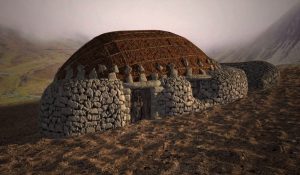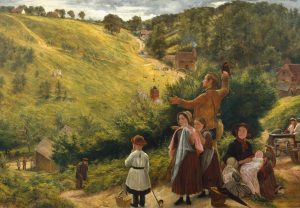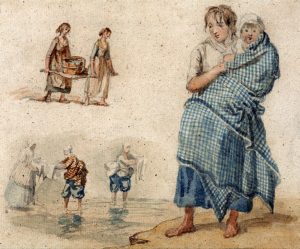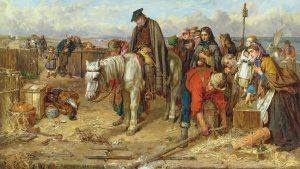
In the Celtic tradition, “Thin Places” are sites where the natural and spiritual worlds meet and intermingle, separated by the merest veil. The ancient Celts would visit these sacred sites, among them Stonehenge in England and the Ring of Brodgar in Orkney, to experience the presence of their gods. For avowedly secular types, the concept works better historically. I think of the reconstructed Gaelic village in the Highland Folk Museum 45 miles south of Inverness, where you can wander in and out of blackhouses and see people at work in the clothing and spirit of another time. The same goes for Auchindrain Township, six miles south of Inverary. It is the only stone-built settlement to survive essentially unaltered from among hundreds that existed before the Highland Clearances. And what of the Gearrannan Blackhouse Village at a beautiful waterside location on the Isle of Lewis?
All three of those sites provide a sense of how most Highlanders lived in the decades before and after the mid-1700s, when the Battle of Culloden marked the beginning of the end for the Old Order. Political and military historians of the Middle Ages focus on kings and aristocrats and the battles they fought, won, or lost. But most Highlanders were farmers who stayed home in small townships made up of extended families.
They lived in “blackhouses,’ so-designated because they were dark, windowless, and blackened by peat-fire smoke. The term distinguishes them from the “white houses” which came later and introduced such amenities as windows and toilets. In Thatched Houses, author Colin Sinclair identifies three types of blackhouses according to their roof styles. The Hebridean has four walls of the same height and a ledge running around the edge of the roof. The Skye has four similar walls but no ledge: the thatch runs over the edge. And the Dailriadic has a Skye-style roof but pointed walls at two opposite ends providing for a pitched roof.

The common features among these three types tell us more about how people lived. Besides their thatched roofs and walls made of stone or peat slabs, blackhouses were usually oblong and divided into three compartments. You would enter the house through a flimsy door that opens into the byre or cow-house that forms one of the two end compartments. You would see two small black cows reclining on a bed of straw. But the place stinks of cow dung and chicken droppings so why tarry? You turn right and, through an opening or pass door, step through an internal wall into the main apartment. The third compartment is straight ahead, divided from this room by a wooden partition containing another pass door covered with a blanket.
You can’t help but notice the smoke, which gets thicker higher up, and you crouch to avoid the worst of it. The smoke curls upwards from a peat fire which sits on a stone slab in the middle of this dirt-floor apartment. It drifts eventually through a hole in the thatch located off-centre so that heavy rains do not douse the flames. A three-legged iron pot hangs over the fire from a chain attached to a beam in the roof. You sit down on a bench that occupies a side wall and notice a dresser neatly displaying rows of plates. Beneath it sits a washtub and beside it a wooden bucket.
Welcome to the house of the Gael in the Old Highlands. It allows for conversation and conviviality around the glowing peat fire, but mainly it provides shelter from the storm – though the roof of the blackhouse is not water tight. In rainy weather, heavy drops of inky black water make their way through the thatch. This happens often enough that people have a name for those falling droplets: snighe.
When weather permits, not surprisingly, the common folk spend most of their time outdoors. They tend their crops and their cattle. When James Boswell passed this way with Dr. Samuel Johnson in 1773, he wrote, “we had not rooms that we could command, for the good people here had no notion that a man could have any occasion but a mere sleeping place.”
Like Ireland, but unlike England and the Lowlands, the Scottish Highlands successfully resisted the invasion of the Romans and never formed part of Roman Britain (AD 43 to 410). The Gaelic-speaking Highlanders on the islands and along the mainland coast belonged to a sea-faring world – one without roads until the 18th century. No coach system reached Inverness until 1811.
And yet, for generations, people survived in this rugged landscape, enduring sporadic famines.
What gave them the strength and ability to do so? Historians are well-nigh unanimous: The clan system: all for one and one for all. Many clansmen were not related to the clan chief by blood, but took his name to show solidarity, to obtain basic protection, or to acquire foods. Loyalty to the clan was paramount.
Highlanders are often thought of as “crofters” who owned and farmed a plot of land. But that crofting organization did not emerge until the mid-19th century. Before that, under a collective “runrig” system of land tenure, farmers lived in their blackhouses in townships that comprised between six and twenty dwellings adjacent to an “infield” of arable land and an “outfield” more suitable to rough grazing. They divided the infield into strips or “rigs” which were reassigned every two or three years so that everyone had a turn working the best land.
 Collective ownership and co-operative activity don’t come easily. In the Highlands, the clan system made them work. That system highlights kinship and shared membership in a welcoming social entity. Clan members share a common ancestor, or at least subscribe to the notion that they do. You are all brothers and sisters and cousins.
Collective ownership and co-operative activity don’t come easily. In the Highlands, the clan system made them work. That system highlights kinship and shared membership in a welcoming social entity. Clan members share a common ancestor, or at least subscribe to the notion that they do. You are all brothers and sisters and cousins.
The clan chieftains, whose ancestors acquired estates from the crown, grant long-term mortgages on large holdings or “tacks” to faithful kinsmen. The “tacksman” serve as a military officer when required, and rents sections of his large tack to sub-tenants. He keeps the best section for himself. While the chief lives in a castle some distance away, the tacksman resides among the people, albeit in the best house in the township.
The relative status of the chieftains depends on the number of men they can bring to a battle. They recognize that they have reciprocal responsibilities and obligations to members of their clan. During periods of famine and hardship, they are known to remit rents and distribute grain. Clan members, while clearly interdependent, belong to one of three main classes. The chiefs are supreme leaders. Next come the gentlemen of the clan, the “tacksmen” who take care to educate their sons, who can then enter the professions or the military. The third class comprises sub-tenants and cottars or servants, who live in the humblest dwellings and do the hardest work of farming.
The tacksman lives in a traditional blackhouse, a low-lying building with dry-stone walls, wooden rafters, and thatched roof. But his place might be set apart from the others and larger than usual, with one or two extensions and perhaps a separate byre for cows, sheep, goats, and chickens. Instead of hard-packed earth, his floor might be built of flagstones.
Most Highlanders are subsistence farmers who eat what they grow – turnips, corn, potatoes. They keep a few small black cows and chickens, sometimes a goat, and use workhorses to till often rocky parcels of land. Everyone in the township is a jack of all trades and women are full partners in the collective enterprise.
Except during winter, everyone works round the clock, doing whatever has to be done.
The men build the houses and continually renew and repair thatched roofs. They also make and mend furniture and do any jobs that require heavy lifting, including digging the land and sowing the seed. The women handle the cows, make wicker baskets, and transport water and manure in buckets and baskets. They tend the corn and potatoes, and they also do the cooking. Generally, breakfast, lunch and supper vary the same elements: porridge, bread, milk, potatoes, sometimes eggs, and possibly fish. Bread would be bannocks of oat or barley meal. In some areas, the grain is exhausted by the end of spring and people live on milk and fish until the potatoes are ready.
As April ends, the township turns to cutting and drying the peats needed to burn through the year for cooking and heating. An average family burns 15,000 peats per year. Several families usually combine their efforts as cutting peats requires two men, one to cut the rectangular cubes out of the ground and the other to lift them onto the bank. This tough, heavy work demands that the two change places frequently. A good team can cut 1,000 peats a day.
 The women spread and stack the peats to dry, often with the help of older children. If the weather cooperates, the peats dry in two weeks. People carry them home in special wooden wheelbarrows called “peat barrows” and pile them near their homes. If they are lucky, they might be able to saddle up a “pack pony” to help with the carrying. This peat cutting takes place during the dry season, when men will also be working the ground and planting turnips.
The women spread and stack the peats to dry, often with the help of older children. If the weather cooperates, the peats dry in two weeks. People carry them home in special wooden wheelbarrows called “peat barrows” and pile them near their homes. If they are lucky, they might be able to saddle up a “pack pony” to help with the carrying. This peat cutting takes place during the dry season, when men will also be working the ground and planting turnips.
The men make wooden pack saddles and collars for horses, ponies and oxen, and primitive sleds on which to drag large stones from the fields. They use fires to crack the largest stones, or else bore holes and fill them with wet wedges that crack the stone as they dry and expand. They make wooden gates to confine cattle and various kinds of rope using rushes, heather, and even horsehair. For this task, they create rope-twisting devices.
In ancient times, Highlanders went barefoot. But then they took to cutting undressed hide to fit their feet, punching holes around the edges and tying what was effectively a moccasin around their ankles. By the 18th century people are tanning leather to make their shoes. On the west coast, where scrub abounds, the women become expert basket makers and even make wickerwork coffins.
For townships situated on a coast, one of the hardest jobs is collecting kelp, an acidic seaweed useful to the era’s chemical manufacturing. Men wade into the freezing cold water to collect the seaweed and then carry it ashore. Because of the cold and constant wetting, many suffer from acute rheumatism. Women dry and burn the seaweed into a slag-like mass for transportation.
Early in the summer, families drive their cattle to the “shielings,” a term that encompasses both the grazing grounds and the nearby herdsmen’s huts or shelters. Families pile carts with blankets, foodstuffs, churns and dishes and place old women and spinning wheels on top. With cattle bawling and dogs barking, the whole community sets out along the rough track that leads to the shielings. On arrival, people unpack, share a simple feast, and say a blessing.
For a couple of months, most of the women, girls and young lads remain at the shielings to care for the cattle and to make cheese and butter. Around the end of July, when the cows have cleared the grass, the women return to the township. The men are already hard at work harvesting grain, desperate to finish before autumn brings the rains.
Although women do some work with textiles, weaving becomes a specialized craft and weavers are relatively numerous. Every man needs his belted plaid, after all — his woven piece of cloth roughly five feet wide and twelve to eighteen feet long, which he wraps around himself one way or another, and which, in the 18th century, slowly evolves into the smaller, more manageable kilt. In addition to weavers, communities need tailors and shoemakers, and every hamlet has a few smiths.

Woodworkers come into their own as fishing grows more efficient, responding to the need for boats and barrels in which to store salted herrings. Boatbuilders make boats out of hollowed logs, but also draw on the Norse tradition of stretching hides over a wooden frame to make larger craft. West-coast Highlanders and Hebridean Islanders have adapted the wooden galleys introduced by the Vikings. In the 16th century, clan chieftains like MacNeill of Barra keep a galley and a crew of men at the ready in case a chance arises for piracy. The MacNeills produce one especially memorable clan chieftain who every evening has one of his minions poke his head out a top-floor window in Kisimul Castle. “MacNeill of Barra has dined!” the servant cries, “And now the world may dine.”
Highlanders lived humbly, alternating between periods of hard work and leisure.
But in Highland Folk Ways, ethnologist Isabel Grant tells us that they enjoyed a mental life “proud, vigorous and beautiful, which has existed in continuity from the days of the supremacy of the lordly Gaelic society.” Grant traces that intellectual life to the Lords of the Isles, those champions of Gaelic culture and patrons of poetry and music who launched a tradition that refused to wither and die.
No description of Highland society, she writes, “can ignore the intellectual life of the people.” Nearly every literate visitor was struck equally by the poverty and simplicity of the people’s lives “and by the distinction of their bearing, their beautiful manners and their courtesy to each other.” In the early 19th century, one visitor remarked on the people’s “stateliness in the midst of their poverty,” while another noticed that “a vein of good breeding ran through all ranks, influencing their manners and rendering the intercourse of all most agreeable.”
Again, Grant points to the Lords of the Isle, descendants of the sea-lord Somerled. Country folk even in remote districts enjoyed “a wealth of stories and traditions handed down by practised story-tellers.” The “noble epics of ancient Gaeldom,” she adds, “conceived and polished when Erin was a kingdom with a magnificent flowering of the arts, were the delight of the Highland society that flourished during the Lordship of the Isles.” Stories from the Feinne Cycle, featuring Deidre, Grainne, and Cuchullin, “formed the everyday background of people’s lives.”
 General David Stewart of Garth, writing of his youth in Perthshire during the late 18th century, observed: “When a stranger appeared, after the usual compliments, the first question was, ‘Do you know anything of the Feinne?’ If the answer was in the affirmative, the whole hamlet convened and midnight was usually the hour of separation.” Another observer marveled:
General David Stewart of Garth, writing of his youth in Perthshire during the late 18th century, observed: “When a stranger appeared, after the usual compliments, the first question was, ‘Do you know anything of the Feinne?’ If the answer was in the affirmative, the whole hamlet convened and midnight was usually the hour of separation.” Another observer marveled:
“In every cottage there is a musician and in every hamlet a poet.”
All this had ancient roots. In the 1500s, trained professional poets wrote in the elaborate, stylized metres of old Ireland. The classic Book of the Dean of Linsmore, begun in 1512, collected the poetry of wandering bards or “strollers” who recited lengthy pieces in the classical metres of the Old Irish that had spawned the Gaelic language.
In the 1600s, with the ancient Gaelic script slowly disappearing, Highland poets produced simpler, more tuneful works. The poets included men and women of every rank, from tacksmen, ministers, and schoolmasters to cattlemen and crofters. That illustrious Lowland-poet Robert Burns was not as anomalous as many people believe. Between 1645 and 1830, according to the scholar W.J. Watson, 130 different Highland poets produced work that was “really good and some of it outstanding.” Meanwhile, many people developed an ability to improvise verse, and to entertain with spontaneous rhyming couplets poking fun at those present.
In his forthcoming book, Flight of the Highlanders: The Making of Canada, author Ken McGoogan turns to the common people, and particularly to those who came to Canada as a result of the Highland Clearances. He tells the story of those forgotten Scots who, frequently betrayed by their own chieftains and evicted from their ancestral lands, found themselves battling hardship, hunger, and hostility in a New World they could scarcely have imagined.




















Leave a Comment